
R and Python are both data analysis tools that need to be programmed. Advanced fields of data mining and analysis, such as machine learning and text mining.Construct data analysis algorithms based on the business scenarios and actual problems.By reading R’s help files and the information on the network, you can solve specific problems relatively quickly. With these bases, when you encounter actual problems, you can find the R package you need to use. 10 days of centralized learning is enough for mastering the basic use, basic data structure, data import and export, and simple data visualization. Data analysis report output (R markdown).įrom my point of view, getting started with R is very simple.Statistical modeling (linear regression, logistic regression, tree model, neural network, etc.).Statistical hypothesis testing (t test, analysis of variance, chi-square test, etc.).As far as our general data analysis or academic data analysis work is concerned, the things that R can do mainly include the following aspects. The functions of R cover almost any area where data is needed. Unlike Python, R, and other open source software, there is a charge for the genuine Excel.The built-in statistical analysis is too simple and has little practical value.The Excel data file itself can hold only 1.08 million rows without the aid of other tools, and it’s not suitable for processing large-scale data sets.When the amount of data is large, there will be a situation of stuttering.To fully master Excel, you need to learn VBA, so the difficulty is still very high.





 0 kommentar(er)
0 kommentar(er)
